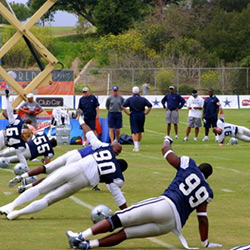Football Injury Prevention

Football is the leading cause of school sports injuries. According to the U.S. Consumer Product Safety Commission, in 2012, approximately 466,492 people were treated for football-related injuries in ERs. Knee injuries are the most common, especially to the anterior or posterior cruciate, ACL/PCL, and to the menisci, cartilage of the knee. Shoulders are susceptible to injury among offensive and defensive linemen.
Tips for Preventing Football Injuries
- Start the football season in good physical condition. During the off-season, maintain a balanced fitness program, including aerobic exercise, strength training, and flexibility.
- All players should have a pre-season physical to determine readiness to play.
- Warm-up with jumping jacks, running or walking for 5 minutes and stretching, holding each stretch for 30 seconds.
- Stretch at the end of practice or play to reduce muscle soreness.
- Drink 24 ounces of fluid 2 hours before exercise and an additional 8 ounces of water or sports drink immediately before exercise. While exercising, drink 8 ounces of water every 20 minutes. Dehydration inhibits athletic performance.
Protective Equipment
According to Pop Warner Football, Office PlayBook, players should have the following protective gear:
- Helmet
- Shoulder pads, hip pads, tail pads, knee pads
- Pants (one-piece or shell)
- Thigh guards
- Jersey
- Mouthguard with strap
- Athletic supporter
- Shoes, non-detachable or detachable cleats based on league
- Eyeglasses with non-shattering, safety glass or contact lenses
Coaches should be knowledgeable about first aid for minor injuries and recognize serious injuries. Coaches should have a plan to reach medical help for significant injuries. DOC is open all day and weekends for immediate expert orthopedic care.




